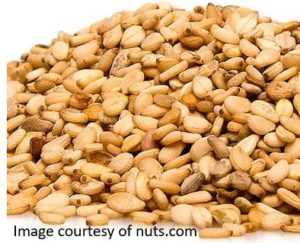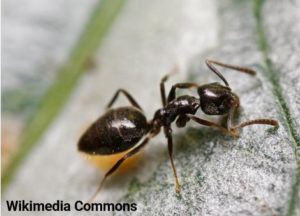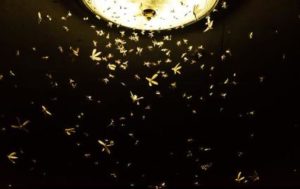The FASTER Act

This topic was previously discussed in the March 2021edition of the Technical Bulletin, this issue will cover the topic at a greater depth.
The “FASTER Act” was passed by The U.S. House of Representatives on April 14, 2021. The act requires sesame be labeled as an allergen on packaged foods. This makes sesame the ninth food allergen for which the Food and Drug Administration (FDA) requires plain-language labeling. Nonprofit organization “Food Allergy Research and Education (FARE)” said “Passage of the Food Allergy Safety, Treatment, Education and Research (FASTER) Act of 2021 has been the highest legislative priority for FARE.” Many food safety professionals and those suffering from food allergies agree.
This also marks the first time since 2004 that a new allergen has been added to the Food Allergen Labeling and Consumer Protection Act (FALCPA). This is a huge win for food allergy advocates and the public as well. Most food sectors have already begun the changing of formulas, labels, and packaging materials to ensure compliance and, in some cases, are reformulating their product recipes to avoid use. The FASTER Act has an effective date of January 1, 2023. However, FDA recommends voluntary disclosure of sesame.
While the U.S. adds Sesame, many countries, and the European Union (EU) have always recognized sesame, and many other foods, as dangerous allergens. Canada, for example, recognizes eleven “priority allergens” and the EU fourteen.
Submitted by: Rich Gibson ACE, CFSQA
The Odorous House Ant

Order: Hymenoptera Family: Formicidae Genus: Tapinoma Species: T. sessile
Tapinoma sessile is a species of small ant that goes by the common names odorous house ant, sugar ant, stink ant, and coconut ant. The Odorous House ants ranges in color from brown to black and varies in length from 1⁄16” to 1⁄8” (1.5–3.2 mm).
The gaster portion of the abdomen sits directly on top of the petiole in the abdomen of this species, which helps distinguish them from other small, dark, invasive ants. The ant’s colonies are polydomous (consist of multiple nests) and polygynous (contain multiple reproducing queens). Like many social insects, T. sessile employs complex foraging strategies, allocates food depending on environmental conditions, and engages in competition with other insects.
According to Texas A&M University’s Urban and Structural Entomology Program “Colonies living indoors in wall voids can be treated by injecting an aerosol or dust insecticide into cracks around baseboards, cabinets, door frames, and around electrical switches and plugs. Nests found outside can be drenched with a residual insecticide. When numerous ants appear around the building foundation, a perimeter treatment with a residual insecticide may repel foraging workers and prevent them from re-infesting the structure. Baits that have a protein or sugar-based attractant may be effective when the nest is not accessible.”
Submitted by: Rich Gibson, ACE, CFSQA
Overcoming Occasional Invaders at Pharma manufacturing site

A few weeks ago, the team was asked to help a major biotech company figure out how ants and other occasional invaders were getting into the facility’s ‘controlled space’, where product is inspected and packaged. The facility management has suspected that staff and/ or suppliers were carrying the pests into the space on their clothing. The assessment began immediately upon arrival to the site and the findings were interesting.
The facility had an elaborate process and hygiene station that all staff and visitors must go through prior to entering the controlled space. The process included use of foot scrubbers, mirror checks and having to walk through an elaborate wind-tunnel to blow off any hair, lint, pests, etc. Once on the other side of the wind-tunnel, everyone had to wear shoe covers, hair nets and gown-up by wearing a lab coat.
After having gone through that process and hygiene station, and knowing that there had been multiple pest sightings, the assessor could confidently rule out staff or visitors carrying-in any pests.
Something was clear when entering the inspection and packaging room; the level of positive air pressure was rather weak. Increasing positive air pressure would be a step towards minimizing pests entering the space from the outside. Once in the room, it was suspected pests are gaining entry from the outside perimeter wall. Several obvious gaps were observed along the drop ceiling perimeter. There also was an emergency exit inside the room that appeared to be sealed, but then again small pests can sometimes breach what appears to be well sealed doors.
What was interesting was the exterior perimeter inspection of that same room. The environment was in the tropics and the daytime direct sunlight and heat is not conducive to pests. This particular perimeter wall was well shaded and evidence of pest activity outside the building supported the suspicion.
For control, a comprehensive approach was designed that included exclusion (using silicone caulk and even food-grade grease around the emergency exit) scheduled perimeter applications using a residual repellent pesticide and transitioning exterior lighting to indirect warm yellow 2700K LED Light bulbs which replicate the soft white light of a traditional incandescent without the same level of pest attraction.
- Take away tips:
• The source is not always obvious
• Structural changes often yield great results
• An extra set of eyes can often pinpoint the problem
• Airflow is essential in controlling pest ingress
Submitted by: Hank Hirsch, BCE
CEO & Founder
RK Environmental Services, LLC






